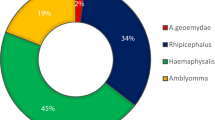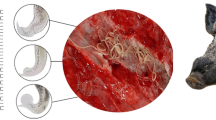Abstract
The two ruminant parasites, Paramphistomum cervi and Carmyerius gregarius, were collected from fresh-slaughtered native cattle at local abattoirs in Sadat district, Menoufia province and identified morphologically, then molecularly by sequencing the nucleotides of 18S ribosomal RNA gene (18S rRNA). The nucleotide sequences of the two isolates were 456 (P. cervi) and 401 bases for (C. gregarius). The data were used along with those of several other helminth species from the GenBank to identify these two species genetically. The nucleotide sequences were aligned using multiple sequence alignments of nucleotides by Clustal W 12.1 V and construct their relationship. Neighbor-joining analytical method was used showing sister relationship between C. gregarius from Sadat district and Gastrodiscoides hominis (EF027096) with relative identity of (98%) due to the presence of single nucleotides polymorphisms (SNPs) in the form of indels as nine nucleotides positions. But when clustering of P. cervi Sadat isolate with Paramphistomoidea sp. S4 isolate P5 (GU735643), this relationship shows complete identity (99%) between them. The homology and diversity was done using Bayesian analyses in MrBayes v3.1. This work will give a useful guide for other researchers for the molecular taxonomic position of Paramphistomatidae spp. in Sadat district among the different species around the world.


Similar content being viewed by others
References
Burland TG (2000) DNASTAR’s Lasergene sequence analysis software. Methods Mol Biol 132:71–91
Cai XQ, Liu GH, Song HQ, Wu CY, Zou FC et al (2012) Sequences and gene organization of the mitochondrial genomes of the liver flukes Opisthorchis viverrini and Clonorchis sinensis (Trematoda). Parasitol Res 110:235–243
Goswami LM, Prasad PK, Tandon V, Chatterjee A (2009) Molecular characterization of Gastrodiscoides hominis (Platyhelminthes: Trematoda: Digenea) inferred from ITS rDNA sequence analysis. Parasitol Res 104:1485–1490
Jia WZ, Yan HB, Guo AJ, Zhu XQ, Wang YC et al (2010) Complete mitochondrial genomes of Taenia multiceps, T. hydatigena and T. pisiformis: additional molecular markers for a tapeworm genus of human and animal health significance. BMC Genomics 11:447
Jones A (2005) Superfamily Paramphistomoidea Fischoeder, 1901. In: Jones A, Bray RA, Gibson DI (eds) Keys to the Trematoda. CABI Publishing and the Natural History Museum, New York Chapter 20& 27
Larkin MA, Blackshields G, Brown NP, Chenna R, McGettigan PA et al (2007) Clustal W and clustal X version 2.0. Bioinformatics 23:2947–2948
Le TH, Blair D, Agatsuma T, Humair PF, Campbell NJ et al (2000) Phylogenies inferred from mitochondrial gene orders—a cautionary tale from the parasitic flatworms. Mol Biol Evol 17:1123–1125
Littlewood DT, Lockyer AE, Webster BL, Johnston DA, Le TH (2006) The complete mitochondrial genomes of Schistosoma haematobium and Schistosoma spindale and the evolutionary history of mitochondrial genome changes among parasitic flatworms. Mol Phylogenet Evol 39:452–467
Lotfy WM, Brant SV, Ashmawy KI, Devkota R, Mkoji GM, Loker ES (2010) A molecular approach for identification of paramphistomes from Africa and Asia. Vet Parasitol 174(2010):234–240
Olson PD, Cribb TH, Tkach VV, Bray RA, Littlewood DTJ (2003) Phylogeny and classification of the Digenea (Platyhelminthes: Trematoda). Int J Parasitol 33:733
Ronquist F, Huelsenbeck JP (2003) MrBayes 3: Bayesian phylogenetic inference under mixed models. Bioinformatics 19:1572–1574
Shaheen HM, Bazh EK (2012) Morphological response of Paramphistomum cervi to treatment with oxyclozanide and niclosamide in vitro. J Egypt Vet med Assoc 72(4):561–574
Shaheen H, Sadek KM, Bazh EK (2013) Evaluation of oxyclozanide and niclosamide combination as alternative antiparamphistomal therapy in buffaloes. Afr J Pharm Pharmacol 7(30):2157–2166. doi:10.5897/AJPP2013.3493
Shalaby IMI, Amer SAM (2012) Preliminary molecular identification of two helminthes (Moniezia sp. and Paramphistomum sp.) in the province of Taif, Saudi Arabia. World Applied Sciences Journal 17(8):986–991
Tamura K, Stecher G, Peterson D, Filipski A, Kumar S (2013) MEGA6: molecular evolutionary genetics analysis version 6.0. Mol Biol Evol 30:2725–2729
Telford MJ, Herniou EA, Russell RB, Littlewood DT (2000) Changes in mitochondrial genetic codes as phylogenetic characters: two examples from the flatworms. Proc Natl Acad Sci U S A 97:11359–11364
Toledo R, Fried B (2014) (eds.) Digenetic Trematodes, Advances in Experimental Medicine and Biology, Volume 766 of the series pp 365–392 (Date: 21 May 2014) Chapter Amphistomes (Digenetic Trematodes) , © Springer Science & Business Media New York 2014. DOI: 10.1007/978-1-4939-0915-5_11
Van Van K, Dalsgaard A, Blair D, Le TH (2009) Haplorchis pumilio and H. taichui in Vietnam discriminated using ITS-2 DNA sequence data from adults and larvae. Exp Parasitol 123:146–151
Wang CR, Li L, Ni HB, Zhai YQ, Chen AH et al (2009) Orientobilharzia turkestanicum is a member of Schistosoma genus based on phylogenetic analysis using ribosomal DNA sequences. Exp Parasitol 121:193–197
Yang X, Wang L, Chen H, Feng H, Shen B, Hu M, Fang R (2016a) The complete mitochondrial genome of Gastrothylax crumenifer (Gastrothylacidae, Trematoda) and comparative analyses with selected trematodes. Parasitol Res 115(6):2489–2497. doi:10.1007/s00436-016-5019-0
Yang X, Wang L, Feng H, Qi M, Zhang Z, Gao C, Wang C, Hu M, Fang R, Li C (2016b) Characterization of the complete mitochondrial genome sequence of Homalogaster paloniae (Gastrodiscidae, Trematoda) and comparative analyses with selected digeneans. Parasitol Res 115(10):3941–3949. doi:10.1007/s00436-016-5160-9
Zheng X, Chang QC, Zhang Y, Tian SQ, Lou Y, Duan H, Guo DH, Wang CR, Zhu XQ (2014) Characterization of the complete nuclear ribosomal DNA sequences of Paramphistomum cervi. Sci World J 2014(2014):751907. doi:10.1155/2014/751907
Author information
Authors and Affiliations
Corresponding author
Ethics declarations
The cattle from which P. cervi and C. gregarius adults were collected were being processed at a local abattoir in Sadat district, Menoufia Province, Egypt, as part of the normal work of the abattoir.
Conflict of interest
The authors declare that they have no conflict of interest.
Rights and permissions
About this article
Cite this article
El-Bahy, N.M., Bazh, E.K., Abdel azizn, A.R. et al. New approach to molecular characterization of Paramphistomum cervi and Carmyerius gregarius and comparative analyses with selected trematodes. Parasitol Res 116, 1417–1422 (2017). https://doi.org/10.1007/s00436-016-5344-3
Received:
Accepted:
Published:
Issue Date:
DOI: https://doi.org/10.1007/s00436-016-5344-3




